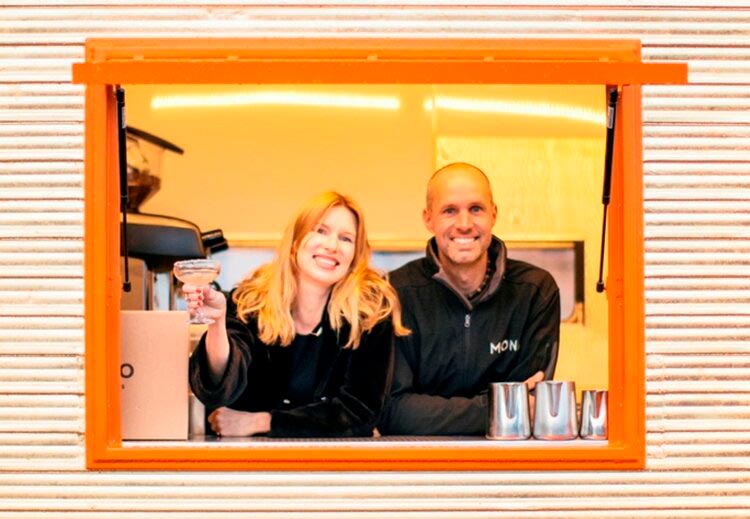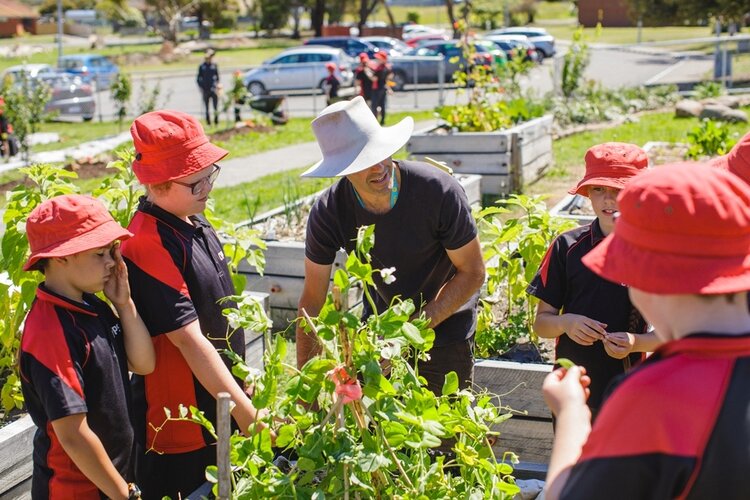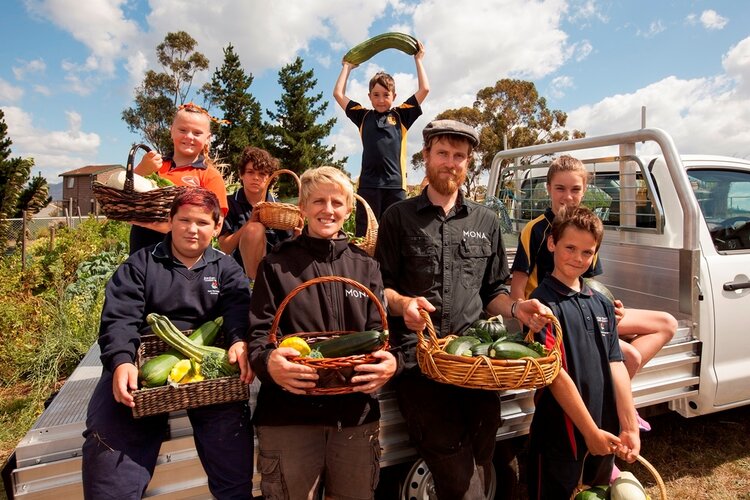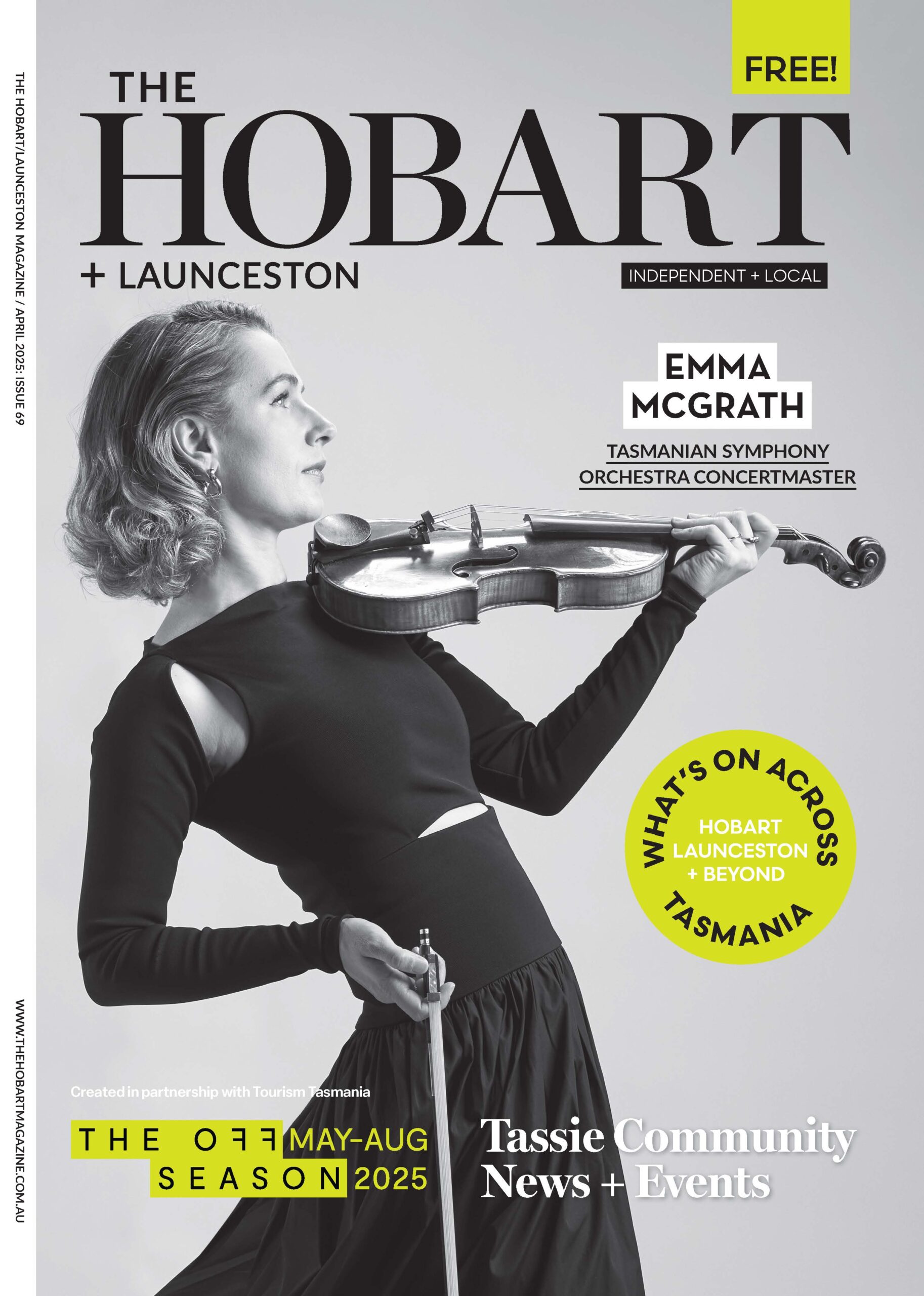24 Carrot Gardens Project
by Stephanie Williams

Kirsha Kaechele is an American artist and curator living in Hobart, and the driving force behind 24 Carrot Gardens. She moved here to live with David Walsh, of Mona and started the program to teach kids the value of understanding where food comes from.
S: What is the 24 Carrot Gardens project and how did it begin?
K: Its first iteration was in New Orleans as a result of doing art projects in a neighbourhood that was very socially economically challenged—to put it mildly. I was just doing contemporary art; I wasn’t interested in social work. But kids in the neighbourhood didn’t have anything to do and were all just hanging around, so I started to structure their time a little more by creating classes taught by volunteer teachers in every possible field—anyone who wanted to teach was invited. We had a cooking class and that’s when I realised they’d actually never seen a real carrot.
S: It’s amazing to think that.
K: It’s astounding. They asked what it was and I said, ‘that’s a carrot’. They said, ‘that’s what Bugs Bunny eats’. So that was the inspiration, I got a grant and started a garden. Because the neighbourhood was so impoverished, it worked well to give it an enterprise angle—everybody loves cash—so the kids started running a business growing vegetables and herbs, picking them and selling them to chefs. I found we could break the social divide by selling only to the finest restaurants in New Orleans. The kids would just waltz through the front door and own the place. They were so cool and they would negotiate in really delightful ways with the chefs and demand more because their produce had just been picked and was organic. Just being able to walk into these chandelier laden places with confidence and something valuable to offer felt very important.
It was so successful and I loved it, so when I came to Tasmania, I wanted to continue that work. I’d learned so much, it felt like I should continue with it. More than anything, I learned the capacity of kids to pick up skills at a stunning speed. It’s hard to believe how quickly they can go from not knowing what a vegetable is to growing, harvesting, cooking, preparing, eating and selling them. So, if kids are sponges in that way then we should be investing in them, because it’s much easier to transform a community’s health by working with children than it is trying to convert adults who are already on the path towards destruction.
S: How do you teach the skills so the information actually gets to the diet decision maker in the family? Or is it flipping it so the child decides what the family eats?
K: I never really had a plan for that and I still don’t have a clear answer, but it just seems to work. From my perspective, the kid understands what real food is, they’re cooking it, growing and eating it in one environment – then, at worst, when they’re at home maybe things haven’t changed much. But when they move out their relationship with food continues and their children will have a very different experience. And of course, from society’s perspective, the cost of public healthcare is going to be significantly lower when you have a generation of 50 year olds who know how to eat. If we want to actually fix society’s problems, we need to work on 50 year timespans, not just election cycles.
That said, I have been delighted and surprised by how much it does seem to infiltrate the kids’ home life. We did an evaluation and a lot of parents are sharing that their kids are forcing them to buy vegetables, that they have pride around a certain recipe and ask their parents to buy those ingredients so they can make the dish at home.
S: How did your New Orleans experience translate to Tasmania?
K: When I came here people explained to me that Mona was in a lower socioeconomic area. They had to explain it because, coming from the US, it didn’t appear that way to me. I mean, we have ghettos. I thought OK, essentially we’re in the equivalent neighbourhood where diet and health outcomes could be improved.
I thought I could start at Mona but it quickly became clear that wasn’t ideal because there’s a barrier and a disconnect–we’re on a peninsula and we have a big fancy gate. The benefit of the project in New Orleans was that it was in the neighbourhood where the kids live. They just walk past and eventually end up in the garden, and they can come regardless of what their parents are up to.
I wanted to do that in Tasmania but then someone suggested starting in the schools and I decided that was a good idea. And so we slowly started, first working with Windemere, Moonah and Goodwood and then expanding into Bridgewater, Gagebrook and more Glenorchy schools. It worked beautifully. But I think there was a lot of suspicion at first from the Department of Education.
S: As to your motives?
K: Yes, understandably it feels like a bit of an assault when a private group comes in with their own agenda. Like, who are you, what are you doing? And so they were quite suspicious and we had to go through a huge amount of bureaucratic hoop jumping, but we got there and now we have the best relationship with them. A lot of schools value the program so much they’ve taken on the funding themselves to which I’m a bit skeptical.
S: Trying to get their own funding for the project?
K: Yes. And if they do that from the community, then I’m 100 percent for it. If they’re doing it from their already miniscule budget I’m not comfortable with it because I fear other programs will suffer. So, I try to invite funders who I know can stick it out.
At the moment it’s easy for the rich to get richer and the class divide is widening. I think as an American, I love freedom, but you can see there are some terrible outcomes when the gap between rich and poor is too great. And if that continues to increase in Australia, well then that’s great justification for more active philanthropy by the wealthy in public systems because they need to make up for it. That’s my attitude and luckily it’s David’s (Kirsha’s husband, David Walsh) attitude too. And I think that’s the attitude of a lot of the funders. The nice thing about 24 Carrot is the funders come from completely diverse political positions. And in fact, one of the funders is probably, in terms of philosophical approach to economics, our mortal enemy, but we have a huge amount of respect for each other when it comes to the fact that we can all agree this is a good program. So, it’s pretty fun to think that David and the Farrells come together on this project. And there’s no worry about green washing considering David’s outspoken position on poker machines!

S: And children’s health isn’t so much a green issue, it’s a health issue.
K: Everyone has their own motivation, a funder might just be interested in enriching the aesthetic environment of Hobart by having a whole new generation of foodies. That might be an aesthetic decision but it could be an economic one as well. We can see now that all the new hotels and restaurants are fighting over qualified chefs and wait staff. We’re constantly poaching each other’s talent. With 24 Carrot we are training the next generation, we’re growing them. A lot of the funders are pragmatic and they see it as a good investment in Tasmania’s economy. Other funders are health driven and there’s an economic argument for that as well. It’s going to cost the state a lot less if people eat well. But for me it’s a justice issue. Every kid deserves basic nutrition and more, they deserve to eat well. We live in a food paradise. It’s unacceptable that some kids are literally malnourished. So 24 Carrot addresses that in a fun way that kids respond to and love.
S: You work with leading architects to design each garden and greenhouse. How do the kids respond to the design process?
K: Beautifully. The more cross disciplinary we can make the program, the better. It opens them up to a new field – they learn what architecture is, what it’s like to design a space, how you consider sunlight, aspect, views and order, or lack of order. The kids sit with architects and talk about what they want out of a garden. Then the architects work with them and treat them like clients and collaborators. They’re very hands on, they do the surveying themselves and lay things out, then we try to have a community volunteer group do the build, which strengthens the link between the community and the school. The more ownership you have of the school by the community, the better the school.
S: Do you have plans to expand the program into other schools in Hobart?
K: I hope to. At the moment, I’m looking for a funder in the north who could support a cluster of schools up there, hint, hint, Dale Elphinstone! For management purposes, it makes sense to start the gardens by the batch because you need a manager who works with the teachers in 4 – 6 schools. Ideally the program will end up in every school but my priority is schools that are most in need, where the kids might have less opportunity for healthy eating at home. And in some neighborhoods the situation is serious. When we give the kids a mandarin they’ve never seen one. They’ve never tasted a cherry. They don’t eat anything fresh. They really do exist on fast food, and sometimes not much of that.
S: What results are you seeing in the children and in the communities around them?
K: According to the teachers, parents and the kids themselves, it’s hugely effective and I’m not surprised in the least because of my hands on experience in New Orleans, where in three months I saw children going from not knowing what a vegetable was to running a business around them. Young minds learn quickly and in a very short time they know the name of every herb and how to use it. They know things even I didn’t know—I visited a garden recently and they told me you can eat broad bean leaves and that they have a recipe for a special salad dressing that makes them more tender.
The gardens have also been useful for the principals in dealing with troubled children because it’s a learning space that’s peaceful and creative—outside the classroom. So when they’re having trouble in class or having behavioural issues, the principals are reporting that the teachers bring the kids into the garden for reflection. I think the emotional healing and that comes from being around living plants is so important. It is completely undervalued in our built environment. And the children seem to understand that. We find a lot of them are choosing to spend their recess in the garden.
S: That’s beautiful. That must feel really good?
K: It feels fantastic. It’s not a chore, it’s a place they want to be. So, they just run into the garden, pick the cherry tomatoes and they pop them in their mouth and the green peas, they love it.
S: What’s next for the project?
K: We have this model that’s very effective in schools and we’re looking to expand it. However, I never forgot about how powerful it is to have a project inside a neighbourhood. I feel like Gagebrook is a neighbourhood that can really benefit from that, so we recently took over two lots there and we’re in the very early stages of developing them. We had celebrity chef Clayton Donovan come down and spend two weeks cooking in the garden—well, it’s not a garden yet, I should say cooking in the abandoned lots—and engaging with all the 24 Carrot kids. He was cooking Aboriginal bush tucker with his gourmet twist. We thought including oysters was really important because although it’s quintessential Tasmanian food and a real point of pride for our state, you’ll find kids in Bridgewater, Gagebrook, and a lot of Tasmanian suburbs have never tasted an oyster. Most of them were scared to try it, but almost everyone at least tasted one which I think is significant. Clayton also prepared fish every day and to my astonishment the kids loved it. They were literally chanting ‘More fish, more fish, more fish.’ Again, a lot of the kids had never had fish. We had a couple of hangis too which the whole neighborhood came out for. It marked the beginning of Bond Place, as we’re calling it, and it’s in its very early stages but we hope that it will become a really wonderful project.

S: So how can our readers get involved?
K: Donations are the easiest way for people to contribute. They can donate on our website or they can come to Mona, have a glass of wine and leave a little envelope. It’s really great when we get the serious funders who are in a position to fund an entire school but there aren’t that many of those in Tasmania, so the more we expand into a broader base of smaller investment the better—now, if you are one of those rich wankers who, like us, owes it to the public to give some of it back, please do come on board. We’d love to have you! But people can also work with the school as a volunteer. Schools are always eager for switched on members of the community to come and offer their insight, skills and services. Or just show up and drop off a fruit tree!

